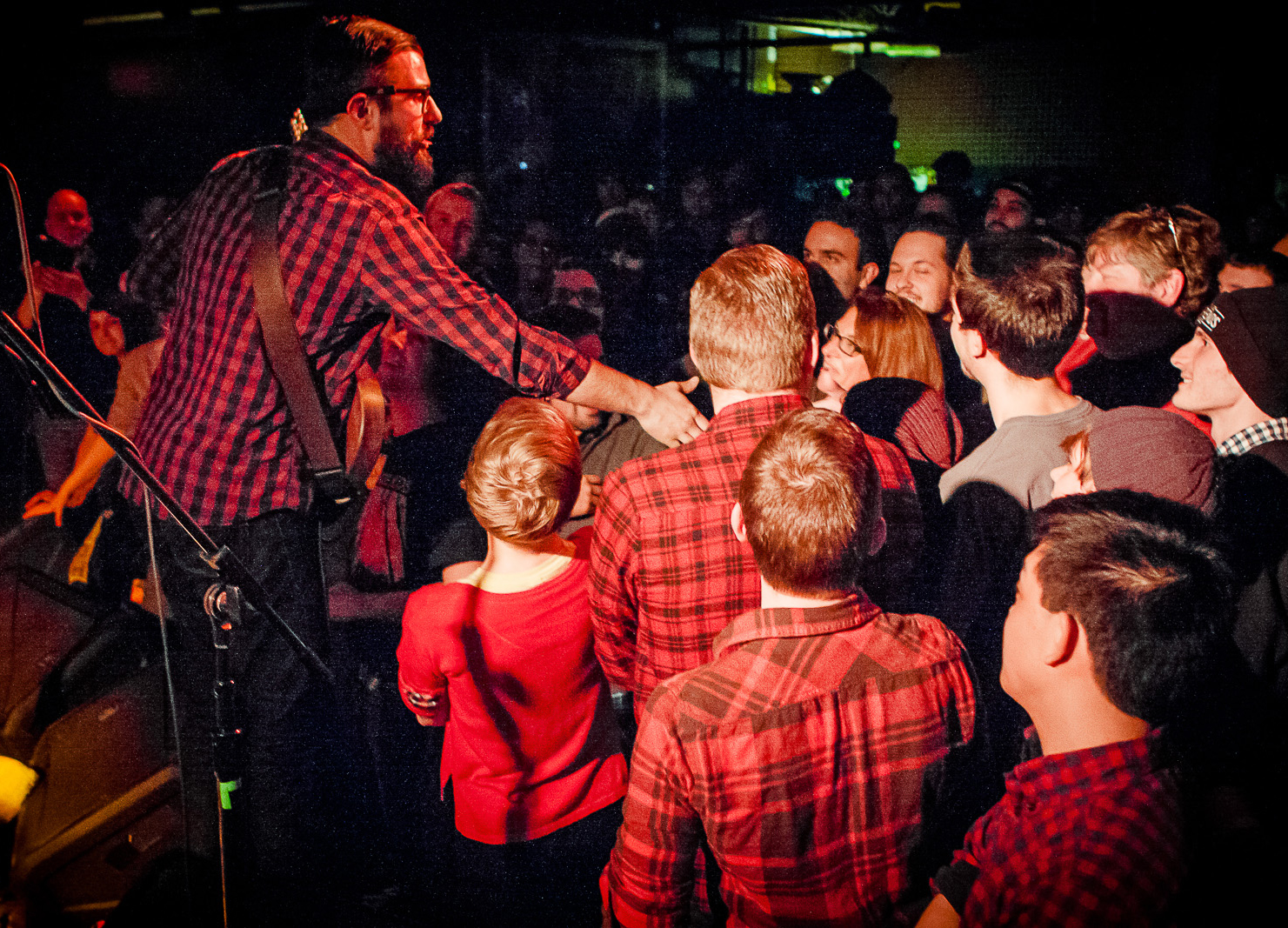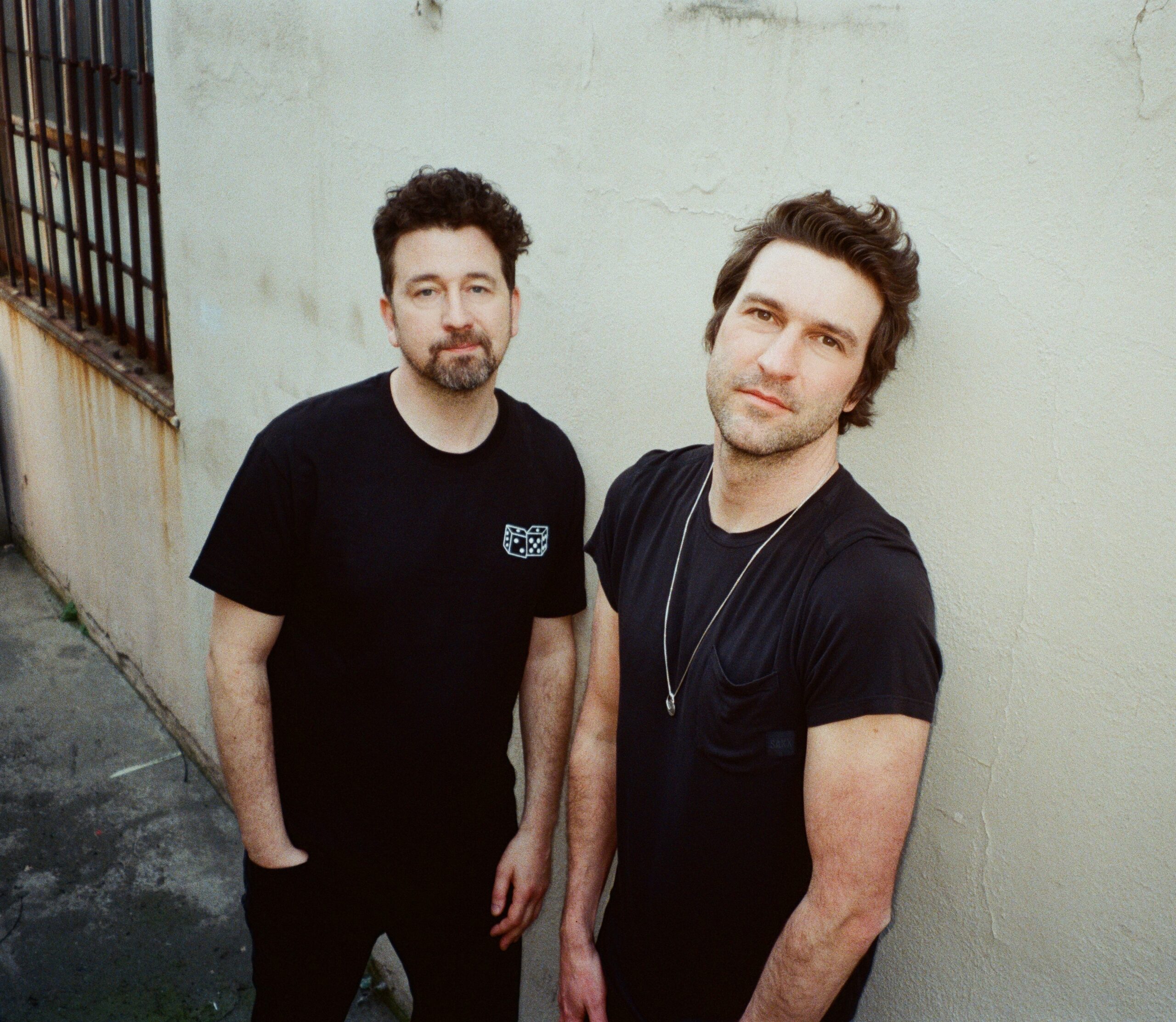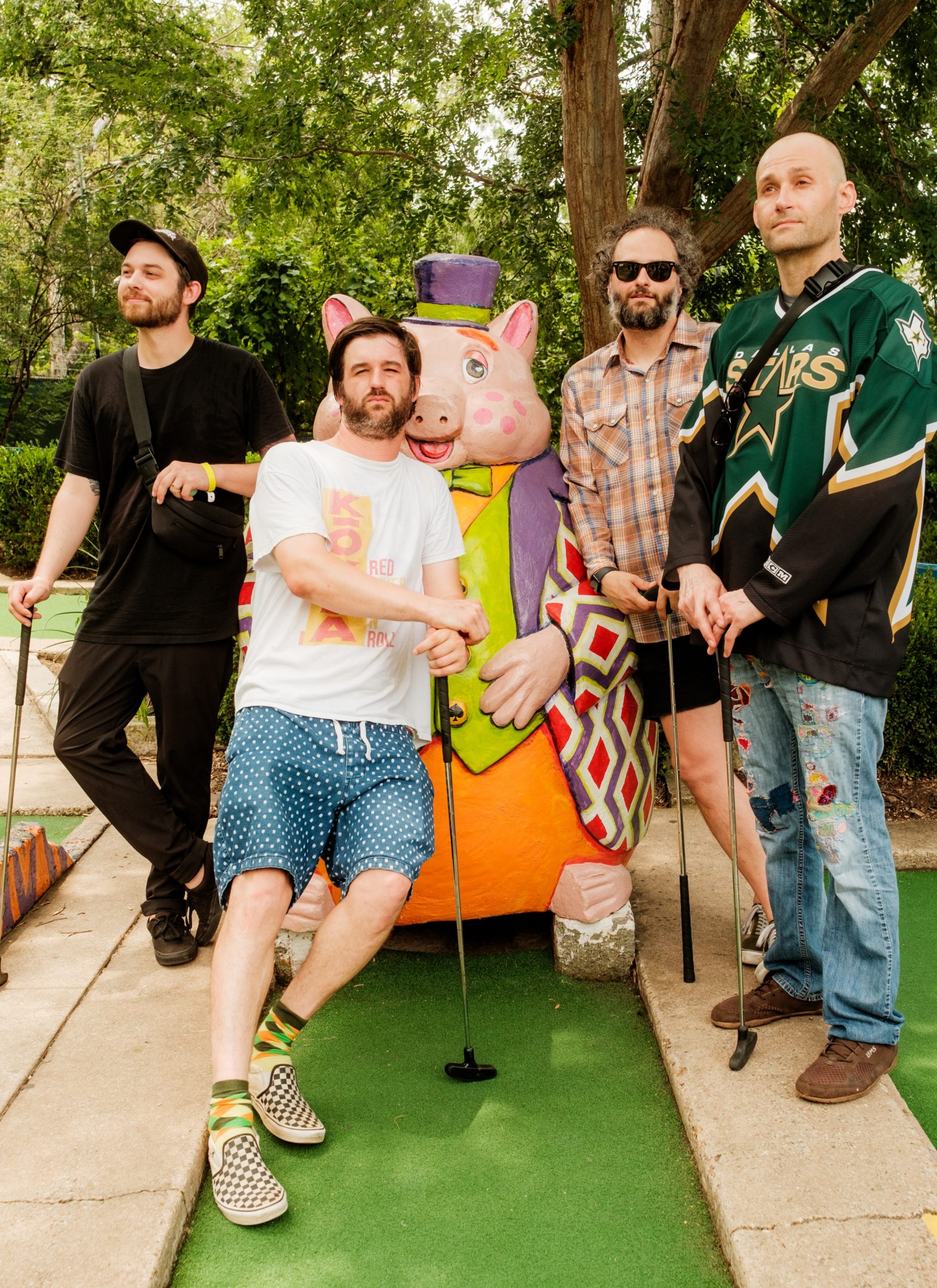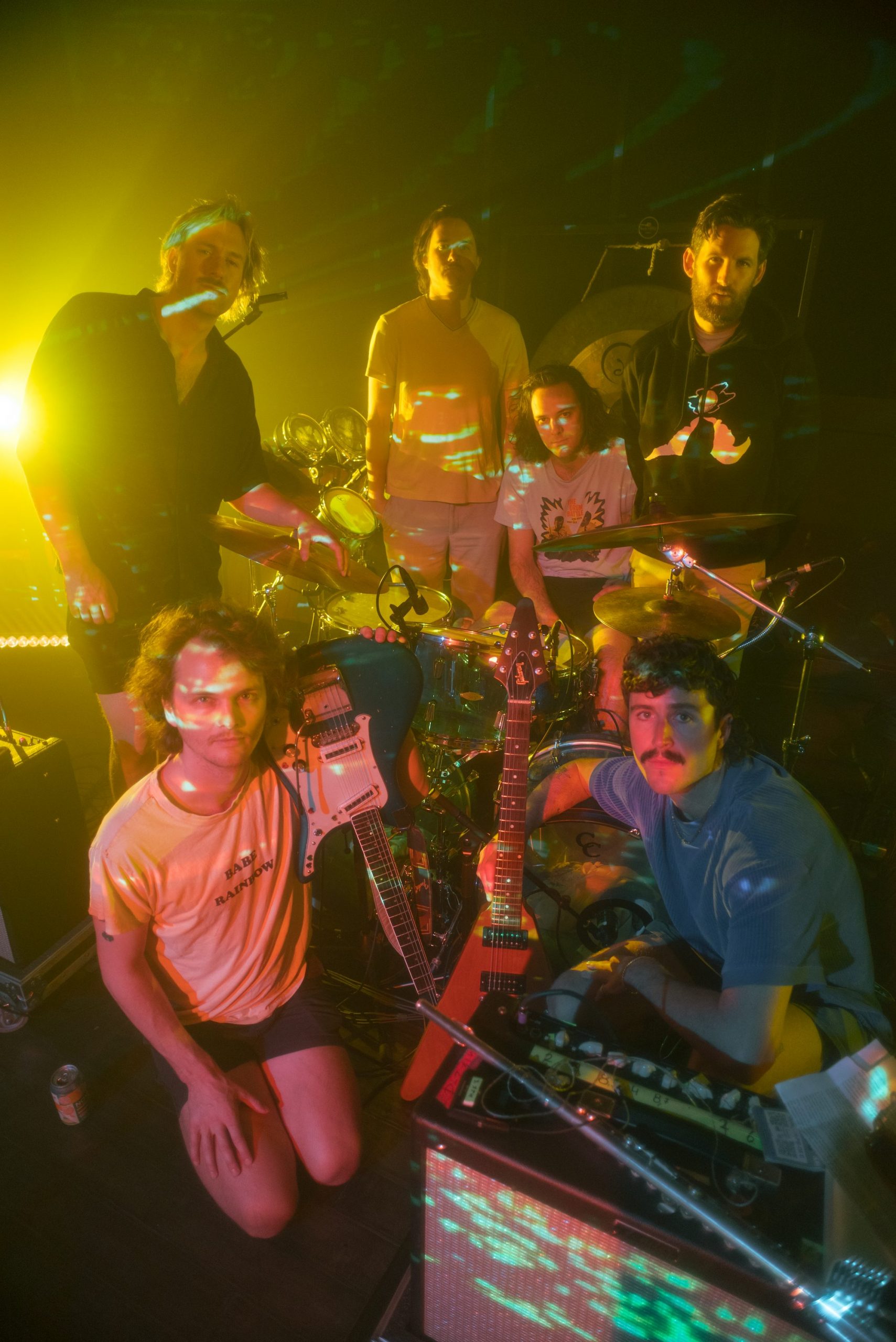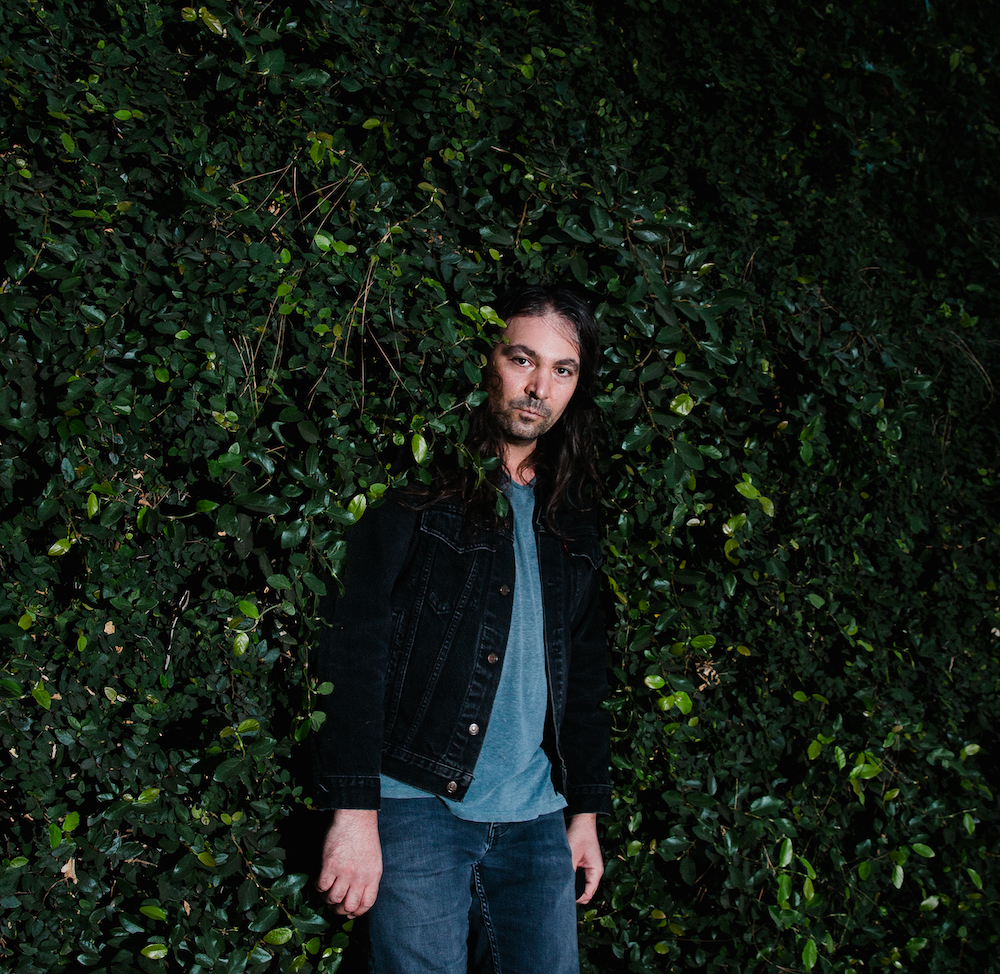"Hell fuckin' yeah!" is Evan Weiss' mantra tonight. He exclaims it between almost every song performed by his band Into It. Over It., his eyes beaming proudly from behind his dark-framed glasses as his square jaw lifts his beard into a giddy grin. The phrase first appears after the set's opener, "Anchor," which, despite Weiss' status as one of the founding fathers of emo's latest wave, sounds like indie-rock choirboy Ben Gibbard covering something by twee lo-fi experimentalists the Microphones -- in other words, a different shade of wimpy than you'd expect. Clad in jeans, sneakers, and a red-and-black flannel shirt, Weiss performs the pensive ballad with just his voice and an acoustic guitar, the same way he's been serenading rock clubs and DIY spaces across the country almost non-stop since founding this project in 2007. Weiss has done this same song this same way countless times at the Akron punk house down the road, sometimes for about a dozen people. But on this bitterly frigid February evening, he's on stage in front of 200-plus highly attentive young adults at the Grog Shop, one of Cleveland's premier hubs for rising stars and cult favorites. "Hell fuckin' yeah, Cleveland!"
After "Anchor," the bandmates Weiss hired last year when he could finally afford to pay bandmates launch into "Heartificial," a one-minute rager built on mammoth post-hardcore power chords and cathartic lyrics such as "How do you sleep at night?!" Those seeking traditional emo signifiers from Weiss can feast on this burst of catharsis, and his fans at the Grog Shop are eating it up tonight. As soon as the band kicks in, the audience is climbing all over each other, fighting their way to the top of the pile to lift their fists and shout along. To Weiss, such enthusiasm merits another hearty "Hell fuckin' yeah." He tells the crowd they're beating out New York as the rowdiest on this tour -- a five-week cross-country jaunt with wordy emo brothers-in-arms A Great Big Pile Of Leaves and The World Is A Beautiful Place And I Am No Longer Afraid To Die -- and implores the crazies to keep it up. "Do not be embarrassed, Cleveland. Let it all hang out."
It's good to be emo these days. Weiss should know; his band is among the most beloved in a network of bleeding-heart rockers that has grown from an obscure but fervent underground presence to a critical and commercial power. This kind of night has become the norm for Into It. Over It. A few days earlier, the band sold out New York's 550-capacity Bowery Ballroom; a day after that they pulled more than 800 people to Philadelphia's Union Transfer. Weiss and his peers have been drawing crowds in the hundreds for a while, but the fervor around their bands went into hyperdrive about six months ago when what had been a slow-simmering grassroots scene boiled over into a media orgy. All at once, a critical establishment that had long turned its nose up at emo suddenly started doling out rave reviews. After years in the wilderness, emo was all the rage.
Into It. Over It. was a prime beneficiary of this press stampede. Last fall, the band's video for "No Amount Of Sound" premiered at MTV, around the same time they were name-checked in emo roundups at Pitchfork, Buzzfeed, and here at Stereogum. What The Chicago Reader identified as emo's fourth wave (after the hardcore reactionaries of the '80s, the creative spleen-venting of the '90s, and turn-of-the-millennium "hair metal" emo) had become a media sensation. The #emorevival was on, with Weiss at the forefront.
[videoembed size="full_width" alignment="center"][/videoembed]
But Weiss is not -- and he wants you to know damn well he's not -- a bandwagon jumper. He knows what it's like to be emo when emo is allegedly dead. Weiss, a few months shy of 30 (though he's already introducing himself as 30), has been playing emotional punk and indie rock for well over a decade, during a period when emo went from a conversation-polarizing force to out of the conversation entirely. First as a member of the "melodic technical indie rock" band the Progress, then solo as Into It. Over It., Weiss was among a small contingent of emo kids keeping the faith. (He's also maintained frequent involvement in side bands such as Up Up Down Down Left Right Left Right B A Start, Pet Symmetry, and Their / They're / There.) Weiss is used to being marginalized and sometimes mocked. Now he and his close-knit contemporaries find themselves in the midst of something far scarier: being cool.
"Everybody's in this uncharted territory," Weiss says, perched at the bar an hour before the show. He remembers how much different things were as a teenager circa 2001 in Cherry Hill, New Jersey, when the Progress was first gigging around nearby Philadelphia. "We would always get lumped onto hardcore and metal shows because no one knew where to put us just because other bands like that just didn't exist anymore. So we'd be the odd man out in a lot of situations." Still, the Progress and fellow Philly emo torchbearers such as Halfway To Holland (a band that later morphed into emo revival forefathers Algernon Cadwallader) kept slugging it out on DIY tours throughout the aughts, spurning pay-to-play shows at huge venues in favor of dive bars and basements. By 2007, the Progress was slowing down, but Weiss wanted to tour harder than ever. So he conceived a solo project, Into It. Over It., and kicked it off with 52 Weeks, one of those endeavors in which a musician writes, records, and releases a new song every week for a year. The following year, Weiss moved to Chicago and started spending 11 months a year on the road, where he was surprised at what his time in the trenches had wrought. "It was fascinating to find out that after years of turmoil trying to book shows and book tours and go to different places and not having anyone to rely on, all the sudden there was this wild underground network of people all doing the same thing," Weiss says. "It became this giant interconnected circle that nobody knew about."

More and more people found out. The new generation of emo bands kept circling the country, and in keeping with the punk-rock lore that dates back to the Ramones and the Sex Pistols, more emo bands started to spring up in their wake. Bandcamp pages with tags like "twinkly" and "midwestern emo" proliferated all over the Northeast, Midwest, and South; local scenes even sprung up as far away as England and Israel. Labels such as Topshelf, Count Your Lucky Stars, No Sleep, and Tiny Engines started snatching up the best of these bands, lending promotional support, and sending them out together on tour. A self-sustaining ecosystem developed with little to no media coverage. By the time the Chicago Reader story appeared last August, many of the scene's bands were drawing hundreds of people to warehouses and midsize clubs. It was the kind of grassroots movement that demands attention, and attention is exactly what it got. All at once, a lot of people who had been unaware of emo's latest wave started weighing in on the #emorevival as if it were a new development. And while it is new in the sense that these bands are reaching unprecedented levels of popularity, it's not like the scene sprung up out of nowhere.
Thus, Weiss -- whose band name, originally a reference to the 52 Weeks project's rapid turnaround time, could just as easily be read as a nod to the fickle nature of the hype cycle -- is ambivalent about the surge in emo coverage. "The fact that people are talking about it all is awesome," he says. Still, "It's existed this whole time. No matter what scale it's been on, it's still existed. So to revive anything, it's kind of silly." For Weiss, who's out there doing the exact same thing he's been doing for years, rejecting the word "revival" is partially a way to resist easy categorization and to disassociate himself from a passing fad. It's another way of saying, "Don't call it a comeback." Ben Thompson of British emo duo Nai Harvest expressed a similar sentiment in a recent Stereogum interview: "More than anything, I don't want this emo revival thing to be really big in 2013, 2014, and then in 2015 there's like a shoegaze revival and no one gives a shit about us anymore. We just don’t want to be a 2014 fashion band. We’ve been doing this for three years, we’ll probably be doing this in a few more years time, and I don’t want to be picked up as an emo band in 2014 and then thrown on the floor when it’s not a trendy thing to like or talk about anymore."
On the other hand, as emo site Property Of Zack explained in a levelheaded essay, "revival" can be defined as "an improvement in the condition or strength of something" and "an instance of something becoming popular, active, or important again," both of which describe what happened to emo last year. A new generation of talent has achieved something like rock stardom, and many of the bands they grew up listening to (Sunny Day Real Estate, Braid, Owls) are reuniting to a legend's welcome. Weiss likes seeing hard work pay off for him and his friends, and he's happy to see the bands that inspired him finding a new audience. Still, no one could fault him for feeling suspicious about suddenly being hailed as hip, especially when he plays a style of music that has traditionally been subject to so much ridicule. Actually, as you might surmise about a genre whose sacred texts include Through Being Cool, in many ways today's emo scene is predicated on not being trendy. "Nobody does this because they want to be cool," Weiss says. "It's not cool to be pathetic. All of us in reality are, in one way or another, kind of pathetic people. And I think that's OK. We're just being ourselves, and that's what's cool about it."
The questions facing this latest class of emo bands are the same questions facing any music community that gets its spotlight moment, particularly those associated with punk or DIY culture: How to know which opportunities to leap at and which ones to pass on? How to stay true to your old fans while welcoming in the new ones? How to avoid buying into your own hype? And how to stay viable when that hype inevitably dies down? The Behind The Music narrative is as old as show business itself, and it's been repeated almost as often as Weiss' punk-rock rhetoric about how he threw himself into a musician's lifestyle for the friendship and the creative fulfillment rather than the money and the fame. It's not that Weiss is lying; he's almost certainly telling the truth when he proclaims, "The point was never to sell records or play big shows. The point was to be bands and enjoy each other's company, the same as it's always been." But he's also telling the truth when he says, "There hasn't been anything different in our scene than anywhere else." Frankly, the tale of the underground musician navigating newfound fame is one nobody needs to hear again. So here's a more pertinent question: Why emo, and why now? What about this particular scene is resonating with so many people at this moment in time? And why is that suddenly so socially acceptable among the hipsterati?
One working theory is that to embrace emo is to reject the state of indie rock -- if you can even call it indie rock anymore. Poptimism, the allegedly anti-elitist philosophy that caused indie-rockers to embrace former genre-pariahs such as dance-pop, R&B, and commercial rap, was in some ways a breath of fresh air, but it didn't end indie culture's ultra-hip posturing so much as alter the shape of that posturing. Exciting new hybrid sounds evolved, but so did a culture built on privilege, mystique, and celebrity worship, one in which huge corporations sponsor mysterious promo campaigns and the biggest pop stars are also the ones getting the most critical attention. That's not necessarily as insidious as it might sound -- that Beyoncé album really was #flawless -- but it could easily be construed as a newer (or is that older?) breed of elitism. Today's emo scene, meanwhile, has consciously rejected the MySpace glamour shots and arena-rock grandeur of emo's Hot Topic era. "I feel like the whole concept of emo is getting back to its roots," A Great Big Pile Of Leaves frontman Pete Weiland says. The resulting community resembles the scrubby, approachable entity indie rock used to be. Says Weiss, "I always just thought of it as indie rock."

It certainly sounds like indie rock. Emo has become the best refuge for those turned off by indie's longstanding flight from guitar-driven rock music toward synthesized pop. At a time when most guitar-based music sounds retro by default, those seeking inventive new guitar-based rock are most likely to find it among this new wave of emo bands. That's not to say there's no nostalgia at play. Spiritually, these bands hearken back to emo's second wave, and some of them -- You Blew It!, Joie De Vivre -- sound like pure throwbacks to that time. The connection to the '90s scene is palpable, and not just because Weiss has opened for Braid and plays in Their / They're / There with a Kinsella brother. Throughout the course of our night in Cleveland, Weiss calls Sunny Day Real Estate his favorite band and Jade Tree his favorite label, and The World Is... member Chris Zizzamia can be heard discussing the Get Up Kids with fans at the merch table. But if the new emo scene bears the sonic influence of its '90s forebears, it also shares that era's penchant for sonic exploration. The Chicago Reader summed up '90s emo's wandering muse like so:
Cap'n Jazz had a spazzy take on the sound that sometimes plunged into chaos; Braid's style was charged and uplifting; the Promise Ring and Get Up Kids went for gigantic, sugary pop hooks; American Football combined emo with math-rock influences and a doleful aesthetic; and the Appleseed Cast ... achieved liftoff with a celestial postrock vibe.
For similar diversity, look no further than the bands on this tour. On the recent Intersections, Into It. Over It. trades in straight-laced pop-rock with punk undertones, but Weiss has dabbled in everything from wispy lo-fi indie-pop to d-beat hardcore. "That's kind of been the underlying part of Into It. Over It. is just doing whatever I want," he explains. Then there's A Great Big Pile Of Leaves, whose punchy, melancholic guitar-pop crossbreeds everything from emo titans Jimmy Eat World and New Found Glory to maudlin crooners such as Morrissey and Jens Lekman to the lightweight songcraft of the Shins and Real Estate to fuzzed-out alt staples like Weezer and Pavement. Perhaps the most ambitious is The World Is..., an eight-piece ensemble with five vocalists whose emo tendencies bleed into vast soundscapes drawing from post-rock and spoken word. When Zizzamia steps to the mic and starts ranting about "reckless acts of self-definition" and the like, he sounds like an especially sensitive Craig Finn fronting Godspeed You! Black Emperor. According to The World Is... guitarist Greg Horbal, dissolving genre boundaries is a conscious decision. "We're not trying to limit ourselves to one genre, per se," Horbal says. "Obviously we draw a lot of influences from emo stuff, but we try to do a lot more too. There are no rules, essentially." As Weiss points out, "emo" is almost as meaningless as "rock" or "indie" anyway. Andrew Wells, a former resident of the Akron punk house Weiss frequented, It's A Kling Thing, says the scene is unified more by ethic than aesthetic. "Everybody started on the same page: writing songs that mean something," Wells says. "They don't have to sound the same."
So it's entirely possible would-be indie rock fans are flocking to the emo scene because they don't like what poptimism has done to indie rock. On the other hand, given that emo has long been the pariah of pariahs, embracing emo might be the poptimists' next logical step. In a post-taste world, the final frontier might not be yacht rock or boy bands but emo. The trend toward eliminating musical taboos has been deeply intertwined with fans and critics reclaiming their old childhood favorites, and for many twentysomethings today that means getting in touch with the old Dashboard Confessional CDs that carried them through adolescence. Plenty of closet emo fans suddenly had a lot of catching up to do when the genre became a cause célèbre. But if the emo revival coverage tended toward trend-conscious dilettantes eager to keep up with the next big thing, Weiss hasn't noticed an influx of cool-hunting interlopers at his shows in the months since emo broke. And if such attitudes did start to infiltrate the scene, he thinks the true believers would know bullshit when they smelt it: "I don't think it's the kind of community where people can get away with that."
Strolling through the Grog Shop tonight confirms Weiss' feeling. The audience is threaded with longtime fans, many of whom got their first exposure to these bands at the Kling house in Akron. Some of them know Weiss personally, and they're uniformly happy to see him expanding his reach. "It fills me with pride," says Wells, who used to help run the Kling house. "It makes me excited to see my friends continually rise up." The prevailing attitude among the emo veterans is definitely not a stereotypical "I was here first" possessiveness -- probably because Weiss is still making an effort to catch up with every old friend in sight tonight. Jon Rogers, who met Weiss about five years ago at the Kling house, fondly remembers Weiss telling long backstories about his songs and bro-ing down after shows. "He's just a cool, honest, funny guy," Rogers says. But there are plenty of newcomers here too, and if they aren't jaded trendmongers, who are they? One trio of Kling house veterans, Raeann, Don, and Babs, has a theory. Speaking from experience, they speculate that much of emo's burgeoning fan base comprises former screamo kids who've grown out of their Underoath phase and moved on to something less juvenile. "It's Tumblr kids," Don suggests. "I'm not saying that disparagingly, but it's a younger crowd than you would normally associate with emo. 'Cause for a while it kind of seemed like emo was in an older, almost burned-out place."
Weiss sees Into It. Over It. as the province of an aging audience too. "We definitely don't appeal to a young crowd because the songs aren't about being young," he says. And several song titles by his emo peers -- Everyone Everywhere's "I Feel Exhausted," Joie De Vivre's "I Was Sixteen Ten Years Ago," Dikembe's "I Just Don't Understand What All These Kids Dig About Him" -- suggest that this latest wave of emo has been largely about coming to terms with coming of age. These past five or six years, while the more fashion-conscious corners of the underground coped with their quarter-life crises by inventing chillwave or getting way into Mariah Carey, Weiss and the emo faithful channeled their millennial angst into snaking guitar parts and nasal howls. At the time, they were a meager demographic moving against cultural currents. But looking around the bar tonight as Into It. Over It. blazes through another ecstatic pop-punk outburst called "Discretion And Depressing People," it's clear that this stuff is starting to click with a younger crowd again too. Those approaching 30 are mostly hanging around the fringes of the club; the chaos up front is all college and high school students. The young people are the ones crowdsurfing and dangling from the rafters. The youth are the ones heeding Weiss' call to go crazy, as youth are wont to do. It appears that if all that #emorevival coverage had any effect, it was to bring emo full circle by turning it over to the kids again. There's a whole new generation ready to be pathetic together, and tonight they're doing Weiss proud. He barely knows what to say, but he musters up the only words he needs: "Hell fuckin' yeah."

[Photos by Joe Boyle.]
